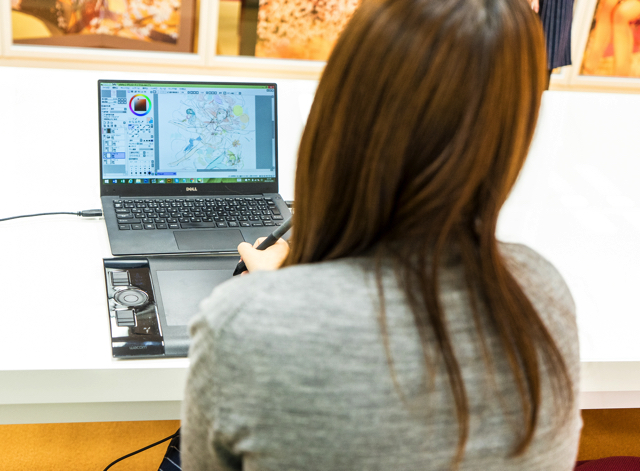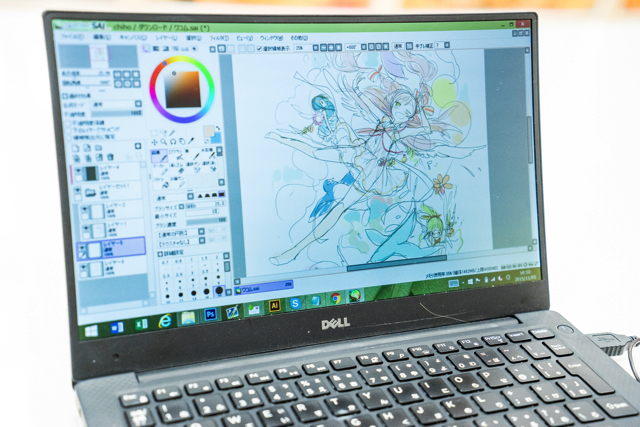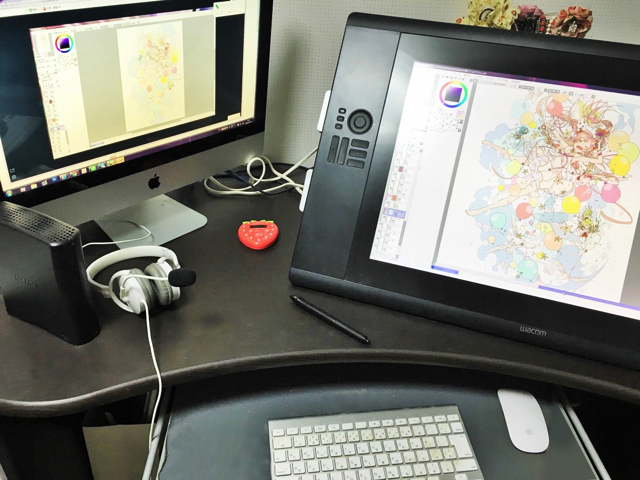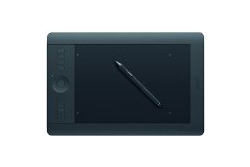メイキングPR
人気絵師ちほさんメイキング&インタビュー!カラフルポップで繊細なイラストの秘密に迫る!
中学生でペンタブレットデビュー!
――ちほさんがイラストを描き始めたきっかけはなんですか?
絵そのものは、幼稚園のころから描いていました。小学生のときに「パソコンのペイント機能で絵を描いてみよう」といった機会はありましたが、本格的にデジタルで描き始めたのは中学生のときですね。
父がいきなり「パソコン買ってきたー!」と帰ってきて。当時のパソコンって今よりももっと高価だったので、家では母をはじめ、家族にかなり睨(にら)まれていたんです。父はその状況を打開するために、私と妹にペンタブレットを買ってきてくれました(笑)。「Bamboo Comic」だったかな? パソコンで絵を描いていてペンタブレットを買ってもらったわけではなく、ペンタブレットを買ってもらったからパソコンで絵を描くようになったという感じです。
父がいきなり「パソコン買ってきたー!」と帰ってきて。当時のパソコンって今よりももっと高価だったので、家では母をはじめ、家族にかなり睨(にら)まれていたんです。父はその状況を打開するために、私と妹にペンタブレットを買ってきてくれました(笑)。「Bamboo Comic」だったかな? パソコンで絵を描いていてペンタブレットを買ってもらったわけではなく、ペンタブレットを買ってもらったからパソコンで絵を描くようになったという感じです。

――いきなりペンタブレットデビューは珍しいですね。
そうですね! 父はペンタブレットと一緒にAdobeのIllustratorも買ってきたんです。もちろん使い方なんて全然分からないので、ああでもこうでもないといじったあとに、Illustratorでは絵が描けないことに気づきました(笑)。そこでインターネット上の「お絵かき掲示板」の存在を知って、足しげく通うようになりました。
私が通っていたところは保存機能がなかったので、ウィンドウを開きっぱなしにして、ひとつの絵を1週間近くかけて描いていました。順調に目も悪くなっていきましたね……(笑)。
私が通っていたところは保存機能がなかったので、ウィンドウを開きっぱなしにして、ひとつの絵を1週間近くかけて描いていました。順調に目も悪くなっていきましたね……(笑)。
――影響を受けたイラストレーターさんや漫画家さんはどなたですか?
種村有菜先生です。私は「神風怪盗ジャンヌ」世代で、種村先生の絵は友達の間でもものすごく人気でした。種村先生のファンが集まるサイトにもよく行っていました。
――今のちほさんの絵柄とは、少しイメージが違う気がします。
昔は、種村先生が描く女の子のように、目が大きくてきらきらしている絵柄だったんですよ! 今も、花びらや髪の感じに影響を受けていると思います。中学校のときに同人誌なんかを見るようになって、ちょっとシュッとした絵になりました。
ひとつの大きなターニングポイントになったのは、大学に入って動画を作り始めたことですね。動画はたくさん枚数を描かないといけないので、絵柄をシンプルにする必要があるんです。それで、当時ギャグコマ用に使っていたデフォルメイラストをもとに描いたら、そちらのタッチのほうが評判がよくって。そのあたりから、目の表現が近いなと思って、さくらももこ先生の影響も受けてます。「こういう絵柄のほうが合うのかもしれないな」と思い、徐々に頭身を上げていって、今に至っています。
ひとつの大きなターニングポイントになったのは、大学に入って動画を作り始めたことですね。動画はたくさん枚数を描かないといけないので、絵柄をシンプルにする必要があるんです。それで、当時ギャグコマ用に使っていたデフォルメイラストをもとに描いたら、そちらのタッチのほうが評判がよくって。そのあたりから、目の表現が近いなと思って、さくらももこ先生の影響も受けてます。「こういう絵柄のほうが合うのかもしれないな」と思い、徐々に頭身を上げていって、今に至っています。
構図や色でシーソーのようにバランスをとる
――ちほさんがイラストを描くときに、こだわっていることはなんですか?
「バランス」ですね。イメージとしてはシーソーのような感じ。実際に傾くわけじゃないんですが、たとえば片側にばかり描きこむと、絵が片方だけ重くなって傾いてしまう気がするんです。
たとえばこのイラスト(下図)だと、初めはもっと小物が少なかったんです。でも、ミクやリンといったキャラクターは「重い」ので、このままだと右に偏った絵になってしまうなと。なので、左側に小物を描きこんだり、木の枝を左側に伸ばしたりしてバランスを調整しました。こうすることで、静止している構図ではあるんですが、流れや動きも出せているかなと思います。
たとえばこのイラスト(下図)だと、初めはもっと小物が少なかったんです。でも、ミクやリンといったキャラクターは「重い」ので、このままだと右に偏った絵になってしまうなと。なので、左側に小物を描きこんだり、木の枝を左側に伸ばしたりしてバランスを調整しました。こうすることで、静止している構図ではあるんですが、流れや動きも出せているかなと思います。
小物はバランスを取るのにとても便利。右下にウサギがいるのは、左側にカボチャを置いたら今度は左が重くなってしまったので、無機物よりも重くて視線を集める動物を配置しよう! という意図があります。しっかり見てほしいほうの線画の密度を上げて、緩急をつけることもすごく意識します。
――そういったバランスを意識するようになったのは、いつごろからですか?
はっきり意識するようになったのは、6~7年前くらいですね。VOCALOIDなどをきっかけに、イラストでお仕事をもらうようになってからです。自分が描きたいところをひたすら描くだけではなくて、「ここをこう描けば、こちらのほうを見てくれるんじゃないか」ということを考えるようになりました。
――すごく客観的に自分のイラストを評価しているんだな、という印象を受けます。
pixivに投稿すると、反応がダイレクトに伝わってくるんですよね。それで「これがウケるんだ」とか「こう描けばみんながグッとくるんだ」ということが分かるようになった気がします。
キャラクターを描くときも、「どうやったらみんなグッとくるんだろう?」と考えながら描きますね。女の子だったら、スカートを短めにしてちょっといやらしさを出してみたり、見てくれた人とばっちり目が合うような語りかける面白さを作ってみたり……。女の子を描く以上、その子に見る人を誘惑してほしいんです!(笑)
キャラクターを描くときも、「どうやったらみんなグッとくるんだろう?」と考えながら描きますね。女の子だったら、スカートを短めにしてちょっといやらしさを出してみたり、見てくれた人とばっちり目が合うような語りかける面白さを作ってみたり……。女の子を描く以上、その子に見る人を誘惑してほしいんです!(笑)
――なるほど! 色についてのこだわりもお聞かせください。
シルエットは気にして塗っています。キャラクターを見せたくて描いているので、背景色を見たときに、キャラの形が分かるようにしたいなと。
それから、色に関しても「バランス」ですね。赤などの強い色があると、どうしてもそちらに目がいくんです。なので、キャラやキャラの近くに強い色を置くようにしてみたり、逆にキャラから離れたところに強い色がある場合は、最終的に色を調整して目立たないようにしたり、左右のバランスを色の強さで調節したりすることもあります。
明度や彩度はかなりいじります。私は普段SAIで色を塗っていますが、「明るさ・コントラスト内」の「色の濃さ」という項目がすごく使いやすい! パステルカラーばかり使うと絵に存在感がなくなりがちなので、この機能での調整はオススメです。
それから、色に関しても「バランス」ですね。赤などの強い色があると、どうしてもそちらに目がいくんです。なので、キャラやキャラの近くに強い色を置くようにしてみたり、逆にキャラから離れたところに強い色がある場合は、最終的に色を調整して目立たないようにしたり、左右のバランスを色の強さで調節したりすることもあります。
明度や彩度はかなりいじります。私は普段SAIで色を塗っていますが、「明るさ・コントラスト内」の「色の濃さ」という項目がすごく使いやすい! パステルカラーばかり使うと絵に存在感がなくなりがちなので、この機能での調整はオススメです。

――Photoshopはほとんど使わないんですか?
メインはSAIですね。Photoshopは最後の加工で使います。印刷用のイラストを描くとき、SAIでRGBで描いて、PhotoshopでCMYKに変換することはよくありますね。
色の調整は本当に難しくて、過去に何度も失敗しています……。黄緑や青緑がRGBからCMYKに変換すると弱くなりがち。なので、ミクさんの髪がつらい!(苦笑) 同人誌の場合は、入稿する前に家庭用プリンタで出力して確かめるようにしています。でも、家庭用のだと再現性が低いので、どうしても再現しないこともあるんですよね……。仕事のイラストは、出版社のデザイナーさんに調整依頼をお願いして、RGBのデータで納品してしまうこともあります。
色の調整は本当に難しくて、過去に何度も失敗しています……。黄緑や青緑がRGBからCMYKに変換すると弱くなりがち。なので、ミクさんの髪がつらい!(苦笑) 同人誌の場合は、入稿する前に家庭用プリンタで出力して確かめるようにしています。でも、家庭用のだと再現性が低いので、どうしても再現しないこともあるんですよね……。仕事のイラストは、出版社のデザイナーさんに調整依頼をお願いして、RGBのデータで納品してしまうこともあります。
早く描ける「Cintiq」、携帯に便利な「Intuos4」
――ちほさんの作業環境を教えてください!
PCはデスクトップで、MacにブートキャンプでWindowsを入れて作業しています。データがどうしても重くなるので、マシンパワーはある程度必要になりますね。
メインで使っているペンタブレットは24インチの液晶ペンタブレット「Cintiq 24HD」です。液晶ペンタブレットのいいところは、とにかく早く描けること。描いているところと視線が一緒なので、紙にペンで描いているような感覚で描けちゃいます。4年前に奮発して買ったんですが、一回慣れてしまうと、このラクさから離れられません(笑)。
サブでは、板型ペンタブレットの「Intuos4」を使っています。携帯に便利なので、お盆や年末年始の帰省をはじめ、その他自宅を離れるときに持ち歩いていますね。どうしても出かけなければいけない日にイラストの締め切りが重なり、急なイラストの修正が入っても、Intuos4なら外出先で対応できます。
PCとUSBで繋げるだけで使えますし、何より薄くて軽いので重宝しています。また、液晶ペンタブレットは紙に描くつもりで描けてしまうぶん、線が少し雑になってしまう気がするので、細かいところは、Intuos4のほうがいいかなと個人的に思いますね。
CintiqもIntuosも、どんどん新しい機種が出てるんですね。いざちゃんと性能を見るとほしくなってきます……(笑)。特にCintiq最新機種の「Cintiq 27QHD」は、ファンクションキーも着脱式になっているので、より便利に使えそうです。解像度もぐっと上がってはかどりそう。あと本体と台座が分かれるようになったので、これなら自分で設置できる……気がします。今使っている機種は分割できないので、買ったとき友人に手伝ってもらってなんとか設置しました。
メインで使っているペンタブレットは24インチの液晶ペンタブレット「Cintiq 24HD」です。液晶ペンタブレットのいいところは、とにかく早く描けること。描いているところと視線が一緒なので、紙にペンで描いているような感覚で描けちゃいます。4年前に奮発して買ったんですが、一回慣れてしまうと、このラクさから離れられません(笑)。
サブでは、板型ペンタブレットの「Intuos4」を使っています。携帯に便利なので、お盆や年末年始の帰省をはじめ、その他自宅を離れるときに持ち歩いていますね。どうしても出かけなければいけない日にイラストの締め切りが重なり、急なイラストの修正が入っても、Intuos4なら外出先で対応できます。
PCとUSBで繋げるだけで使えますし、何より薄くて軽いので重宝しています。また、液晶ペンタブレットは紙に描くつもりで描けてしまうぶん、線が少し雑になってしまう気がするので、細かいところは、Intuos4のほうがいいかなと個人的に思いますね。
CintiqもIntuosも、どんどん新しい機種が出てるんですね。いざちゃんと性能を見るとほしくなってきます……(笑)。特にCintiq最新機種の「Cintiq 27QHD」は、ファンクションキーも着脱式になっているので、より便利に使えそうです。解像度もぐっと上がってはかどりそう。あと本体と台座が分かれるようになったので、これなら自分で設置できる……気がします。今使っている機種は分割できないので、買ったとき友人に手伝ってもらってなんとか設置しました。

――ちなみに、おすすめのショートカットメニューなどはありますか?
CLIP STUDIO PAINTも使っているので、SAIとCLIP STUDIO PAINTはだいたい同じところにキー登録をしています。GキーがGペンで、Mキーが丸ぺン。CLIP STUDIO PAINTはGキー2回で塗りつぶしなんですが、SAIではそういう登録のしかたができないので、Fキーを割り当てています。あとはAltでスポイトを使ったりしています。
――作業用BGMや、気分転換方法を教えてください!
実は、あまり作業用BGMを聞かない方です。基本的に部屋で無音の状態で描いてますね。CDジャケットを描くときは、その曲をずーっと聴きながら描いてます。
いちばんツラくなるのは線画の行程なので、そこで気分転換するために音楽を聞いたり、Twitterやpixivを見たりはします。でも、そのあいだはやっぱり線画が進まないので(笑)レッドブルを飲んで描いちゃうことが多いです。ただ「今日はどうしてもデッサンが狂う」みたいにすごく調子が悪いときはあります。がんばって描いてもデッサンが狂った絵しか生まれないので、そういうときはムリして描かないようにしています。
いちばんツラくなるのは線画の行程なので、そこで気分転換するために音楽を聞いたり、Twitterやpixivを見たりはします。でも、そのあいだはやっぱり線画が進まないので(笑)レッドブルを飲んで描いちゃうことが多いです。ただ「今日はどうしてもデッサンが狂う」みたいにすごく調子が悪いときはあります。がんばって描いてもデッサンが狂った絵しか生まれないので、そういうときはムリして描かないようにしています。
絵を見てもらえると思う「生きてていいんだ!」
――ちほさんは、CDジャケットのイラストや小説の表紙や挿画、earth music&ecologyとのコラボレーションなど、幅広くお仕事していらっしゃいます。仕事ではどういうことに気をつけていますか?
「どういうところを伝えたいのか」「どういう面白さがあるのか」をヒアリングして、いろいろやり取りをしながら構図を考えるようにしています。キャラクターはとにかくカッコよく・可愛く描こうとしていますね。
それから、「このイラストがどこで使われるか」に応じて、イラストの構図や雰囲気を変えています。earth music&ecologyさんとのコラボレーションのときは、初音ミクのキャラクター性を残しつつも、あまりオタクっぽくなく、おしゃれに見えることを目指しました。なので、コラボレーション第1弾のときは、あえて初音ミクの足をすごく細くしてみたり、漫画絵よりもデザイン絵に近いイメージにしています。
ほかにも、動画に使うイラストだったら、曲のイメージに合った絵にするのはもちろんですが、「サムネ映え」ということを考えなきゃいけない。小さく表示されてもシルエットが可愛く見えるかどうかには気をつけますね。
それから、「このイラストがどこで使われるか」に応じて、イラストの構図や雰囲気を変えています。earth music&ecologyさんとのコラボレーションのときは、初音ミクのキャラクター性を残しつつも、あまりオタクっぽくなく、おしゃれに見えることを目指しました。なので、コラボレーション第1弾のときは、あえて初音ミクの足をすごく細くしてみたり、漫画絵よりもデザイン絵に近いイメージにしています。
ほかにも、動画に使うイラストだったら、曲のイメージに合った絵にするのはもちろんですが、「サムネ映え」ということを考えなきゃいけない。小さく表示されてもシルエットが可愛く見えるかどうかには気をつけますね。
――確かに、『1925』などに使われているイラストは、サムネでも見やすく、しっかり可愛いです。
ありがとうございます。『1925』も『メランコリック』も、代表的な作品としていろんな人に見てもらえて、ありがたいです。
※『1925』『メランコリック』……ちほさんがイラストを手がけたVOCALOIDの楽曲。
――今年9月には、画集「ポエミーポエミー」も発売されました!
こんなに描いたんだなあ……と感慨深いです。「自分の絵って、良いんだろうか?」という疑問が常にあるんです。でも、買ってくれて、レスポンスをくれる人がいるのが見えると、すごく感動しますね。大げさかもしれないですが、「生きてていいんだ……!」という気持ちです(笑)。
これからも、もっと新しいことに挑戦していけたらいいと思っています。オリジナル作品や漫画にもどんどんチャレンジしていければ。
これからも、もっと新しいことに挑戦していけたらいいと思っています。オリジナル作品や漫画にもどんどんチャレンジしていければ。
――ありがとうございます。最後に、絵を描くことが好きな中学生・高校生にメッセージをお願いします。
やってみたらできることって意外とあるもんです。昔からイラストレーターや漫画家にすごく憧れていたんですが、そういう、本屋さんやお店に並んでいるような方の絵って「私とは違う、特別な誰かが描いてる。私には無理。」みたいに思ってました。とはいえとにかく頑張ってみると、なんとかなるもんなんだなと……!
人生一度きり、やったもん勝ちっぽいです。がんばりましょう……! あとコミケ3日目出るのでよろしくおなしゃす!
人生一度きり、やったもん勝ちっぽいです。がんばりましょう……! あとコミケ3日目出るのでよろしくおなしゃす!
ちほさん画集

VOCALOIDのイメージイラストを初期から支える人気イラストレーター・ちほの初画集。
VOCALOID関連のイラストはもちろん、書籍カバーや、企業タイアップ、さらには同人誌に収録されたイラストまで、イラストレーター・ちほのこれまでを詰め込んだ、ファン必携の一冊です。
VOCALOID関連のイラストはもちろん、書籍カバーや、企業タイアップ、さらには同人誌に収録されたイラストまで、イラストレーター・ちほのこれまでを詰め込んだ、ファン必携の一冊です。
ちほさん使用ペンタブレットの最新版

Cintiqシリーズの最上位ペンモデル「Cintiq 27QHD」は、高解像度で精細な表現や細かな編集ができ、シリーズ内で最も色域が広い液晶ペンタブレットです。ファンクションキーはリモコン型になり、まるでペンと紙で描いているかのような描き心地は、より効率的なワークフローを実現します。

優れたペン機能と直感的なマルチタッチ機能を兼ね備えた、プロフェッショナルペンタブレット「Intuos Pro」。正確に、思い通りの操作性で、クリエイターの高度な表現力と創作をサポートします。



現在ワコムでは塗り絵コンテストを実施中!
ワコムキャンペーンサイト: http://tablet.wacom.co.jp/article/nuricon